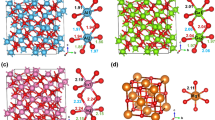Abstract
We propose a new criterion for predicting the first growing phase and the phase growth sequence in a binary system in which several compounds are formed: the free surface energy of the components and compounds. The compound with the lowest free surface energy is the first to grow. The sequence of formation for layers of the other possible compounds is determined by the values of their free surface energies. If compounds exist in the system with close surface energies, the compound with fewer atoms in the unit cell is more likely to form first. We propose using the S. I. Popel'-V. V. Pavlov equation to calculate the free surface energy of hard intermetallics. We demonstrate the high predictive power of the proposed criterion.
Similar content being viewed by others
REFERENCES
V. N. Yeremenko, Ya. V. Natanson, and V. I. Dybkov, “Interaction of the refractory metals with liquid aluminium,” J. Less-Common Met., 50, No. 1, 29-48 (1976).
Ya. V. Natanzon, M. L. Gorb, and V. I. Dybkov, “Mechanical strength and heat resistance of a stainless steel–aluminum bimetal,” Fiziko-Khimicheskaya Mekhanika Materialov, No. 3, 51-53 (1980).
V. N. Eremenko, Ya. V. Natanzon, and V. I. Dybkov, “Making continuous joints between aluminum and refractory metals,” Avtomat. Svarka, No. 1, 27-30 (1976).
V. N. Eremenko (ed.), The Physical Chemistry of Inorganic Materials. Vol. 3. The Physical Chemistry of Reaction between Liquid Metals and Materials [in Russian], Nauk. Dumka, Kiev (1988).
V. I. Dybkov, “Formation of layers of chemical compounds in reaction couples: sequence, stability, and kinetics,” Poroshk. Metall., Nos. 7–8, 36-43 (1996).
V. I. Dybkov, “Characteristics of reactive diffusion and phase formation in the binary systems Ni–Bi, Ni–Zn, and Co–Zn,” Poroshk. Metall., Nos. 7–8, 131-137 (2001).
O. V. Duchenko and V. I. Dybkov, “Kinetics of formation of an intermetallic layer of nickel with bismuth,” Zhurn. Fiz. Khim., 71, No. 3, 433-435 (1997).
Kh. B. Khokonov, “Methods for measuring surface energy and surface tension of metals and alloys in the solid state,” in: Surface Phenomena in Melts and Solid Phases Resulting from Them [in Russian], Shtiintsa, Kishinev (1974), pp. 190-261.
Yu. M. Ivashchenko and V. N. Eremenko, Principles of Precision Measurement of the Surface Energy of Melts by the Sessile Drop Method [in Ukrainian], Nauk. Dumka, Kiev (1972).
S. I. Popel', Surface Phenomena in Melts [in Russian], Metallurgiya, Moscow (1994).
V. I. Nizhenko and L. I. Floka, Surface Tension of Liquid Metals and Alloys [in Russian], Metallurgiya, Moscow (1981).
V. N. Eremenko (ed.), The Physical Chemistry of Inorganic Materials. Vol. 2. Surface Tension and Thermodynamics of Metallic Melts [in Russian], Nauk. Dumka, Kiev (1988).
S. I. Popel' and V. V. Pavlov, “Description of surface tension isotherms for solutions,” in: The Physical Chemistry of Surface Phenomena at High Temperatures [in Russian], Nauk. Dumka, Kiev (1977), pp. 16-26.
V. I. Nizhenko, “Predictive power of equations for surface tension isotherms as applied to binary metallic melts,” Adgeziya Rasplavov i Paika Materialov, Issue 27, 10-19 (1992).
L. M. Shcherbakov, “Thermodynamics of microheterogeneous systems,” in: Surface Phenomena in Melts and Powder Metallurgy Processes [in Russian], Izdat. Akad. Nauk UkrSSR, Kiev (1963), pp. 38-46.
S. N. Zadumkin and A. A. Karashaev, “Relationship between surface energies of metals in solid and liquid phases,” in: Surface Phenomena in Melts and Solid Phases Resulting from Them [in Russian], Kabardino-Balkar. Kn. Izdat., Nal'chik (1965), pp. 85-88.
A. E. Vol, The Structure and Properties of Binary Metallic Systems [in Russian], Fizmatgiz, Moscow (1959), Vol. 1.
S. I. Novikova, Thermal Expansion of Solids [in Russian], Nauka, Moscow (1974).
M. Hansen and K. Anderko, Constitution of Binary Alloys: in 2 Volumes [Russian translation], Metallurgizdat, Moscow (1962).
F. J. J. Loo and G. D. Rieck, “Diffusion in the titanium–aluminium system. I. Interdiffusion between solid Al and Ti or Ti–Al alloys,” Acta Metall., 21, January, 61-71 (1973).
F. J. J. Van Loo and G. D. Rieck, “Diffusion in the titanium–aluminium system. II. Interdiffusion in the composition range between 25 and 100 at.% Ti,” Acta Metall., 21, January, 73-84 (1973).
V. R. Ryabov, Welding by Melting of Aluminum with Steel [in Russian], Nauk. Dumka, Kiev (1969).
G. F. Bastin and G. D. Rieck, “Diffusion in the titanium – nickel system. I. Occurrence and growth of the various intermetallic compounds,” Metal. Trans., 5, August, 1817-1826 (1974).
Yu. V. Naidich, Contact Phenomena in Metallic Melts [in Russian], Nauk. Dumka, Kiev (1972).
V. I. Nizhenko, “Experimental estimate of the free surface energy of solids,” in: Surface Phenomena in Melts [in Russian], Nauk. Dumka, Kiev (1968), pp. 118-126.
V. I. Nizhenko and L. I. Floka, “Surface properties of iron–carbon melts at melt–vapor and melt–graphite interphase boundaries,” in: Surface Phenomena in Melts [in Russian], Nauk. Dumka, Kiev (1968), pp. 130-139.
D. S. Williams, R. A. Rapp, and J. P. Hirth, “Multilayer diffusional growth in silver-zinc alloys,” Metal. Trans., 12A, 639-652 (1981).
Author information
Authors and Affiliations
Rights and permissions
About this article
Cite this article
Nizhenko, V.I. Free Surface Energy as a Criterion for the Sequence of Intermetallic Layer Formation in Reaction Couples. Powder Metallurgy and Metal Ceramics 43, 273–279 (2004). https://doi.org/10.1023/B:PMMC.0000042462.03736.18
Issue Date:
DOI: https://doi.org/10.1023/B:PMMC.0000042462.03736.18




